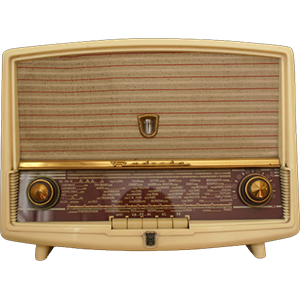
SFR: Rapid growth thanks to the war
In 1910, the polytechnician Emile Girardeau, the engineer Joseph Berthenod, and the mathematician André Blondel founded the Société Française Radioélectrique. Their objective was to establish an industry capable of producing TSF sets in France, directly from raw materials. The opportunity arose in the Congo colony: the governor wanted to establish a radio link between Pointe-Noire and Brazavile.
During the First World War, S.F.R. manufactured and delivered dozens of radio stations, as well as numerous sets for the air force, navy and army.

Radiola AR-812 superheterodyne receiver 1918 – Credit Wikimedia
In 1918, the company's experience attracted investment. Emile Girardeau then created the holding company of the Compagnie générale de télégraphie, of which he was president. One of its branches was the S.F.R.
Radiola: Birth of the first private radio station
In 1921, Girardeau proposed to the State a "public service of information, music, singing and broadcasting of various works by requesting resources from advertising", and obtained the creation of the first European private station. S.F.R. created the brand Radiola for all the transmitters and receivers of TSF. The flagship program of the new private radio station beared the same name and was broadcast for two years.

Réclame pour l’émission Radiola – Crédits Wikipedia
Philips' takeover
In 1929, the Compagnie générale de télégraphie bought Radiotechnique, a French company created ten years earlier and manufacturing lamps for the TSF. The new arrival was entrusted with the production of Radiola radio receivers.
Then, in 1931, Radiotechnique made financial agreements with Philips. From the following year, the Philips sets sold in France were manufactured in the factories producing the Radiola receivers. From then on, only the marketing changed: Philips and Radiola sets were technically and often visually identical.
Radiola had a great reputation in France, and Philips couldn't import parts from Holland because of different French standards, so the two brands continued to coexist in France. In the 1950s, Radiola diversified by also producing household appliances.



Transistors Radios Radiola – 1958
From the seventies to the dissolution
The man walked on the Moon in 1969 and Radiola drew a record player with futuristic curves whose success was immediate. If his official name was Patrice, he is now better known as UFO (Unidentified Flying Object).

In the early 1970s, the brand managed to find a place for itself in the new mass-market channels. Two decades later, competition from Asia and the disappearance of specific French standards dealt Radiola a fatal blow. Philips gradually phased out its products and the brand was dissolved in 2002.
S.F.R. has meanwhile diversified into telecommunication networks, and has become one of the heavyweights of mobile networks in France.



